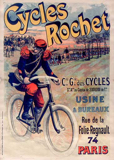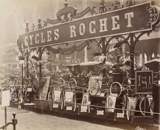Cycles Rochet was the bicycle brand of Compagnie Generale des Cycles a bicycle manufacturer possibly with a head quarters in Paris and a factory in Albert in the Somme. Albert is, perhaps, most famous for being totally, and I mean totally, destroyed in the Battle of the Somme in World War I. If the phrase 'Battle of the Somme' conjours up images of mud-filled craters, dead horses, buildings razed literally to the ground, endless drizzle and random burned sticks poking up here and there, then you are probably picturing Albert in 1916.
Cycles Rochet appears to have been a rather high quality brand, with an equally high profile in the years between 1895 and 1914. It also appears to have flourished right through until the 1960s. Google gives the english word 'ratchet' as the translation of the French word 'rochet'. Freewheels, with their in-built ratchets were the wonder of the 1890s cycling world, but it still seems a slightly odd brand name.
Cycles Rochet is included on this site because the legend goes that Jean Loubeyre's La Polyceler derailleur (possibly the first derailleur in recorded history) was featured in the 1896 catalogue of Compagnie Generale des Cycles, which I can only take as meaning that it featured in the Cycles Rochet catalogue from that year.
La Polyceler is a particular problem for derailleur historians, because, with the exception of the famous patent, there is so little evidence for its physical existence. This makes any verifiable connection with Cycles Rochet particularly important.
While worrying away at this problem, a French correspondent has pointed out some vague, but interesting connections. His contributions go as follows:
- On its many posters from 1890s, Cycles Rochet makes a point of featuring soldiers riding its bicycles. There seems to be some particularly strong connection between the brand and the French army.
- On Delcampe.net, a site on which french people like to sell collectibles, there have been a number of vintage documents for sale that are invoices issued by 'J Loubeyre, chef armurier au 54e d'infanterie'.
- These invoices date from the 1890s.
- They are for repairs to, and spares for, firearms.
- They appear to be issued to army units based in St Étienne.
- At the time many companies involved in the manufacture of firearms were also making bicycles and bicycle components.
- Also at the time, St Étienne was, arguably, the very centre of both the French bicycle and the French firearms industries.
- Could it be that Jean Loubeyre was a supplier of firearm-related services to the French army, and that this was the connection to Cycles Rochet?
The evidence is thin, but entertaining.



